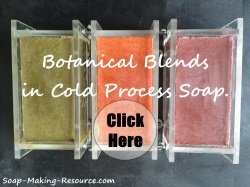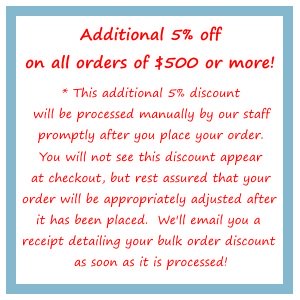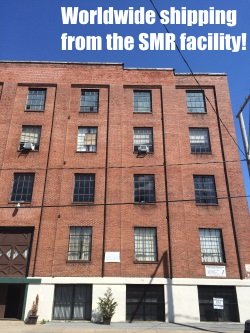Lavender Soap Recipe
On this page, I will be describing how to make my lavender soap recipe with added colloidal oatmeal and all natural oat milk. Never used oat milk in soap making before? Read this tutorial and give it a try in your next batch. It is some great stuff!
In this tutorial, I will share with you my exact formula for making my lavender soap recipe and also show you how to make your very own all natural oat milk and describe exactly how to incorporate it into your batch.
For this soap recipe batch, we will be adding Soap Making Resource's all natural Lavender 40/42 Essential Oil.
This lavender soap recipe will make a 5 pound batch and we are using Soap Making Resource's 5 pound acrylic slab soap mold.
Here is a picture of our finished lavender soap:
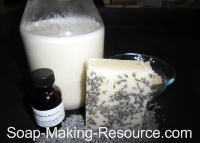
Get the Kit! (Out of Stock)
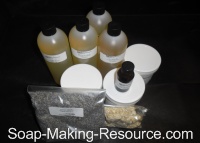
Get the lavender soap recipe kit today and receive all the ingredients to make this great lavender soap! The kit will include 32 ounces of olive oil, 13.5 ounces of palm oil (RBD), 13.5 ounces of coconut oil (76 degrees), 16 ounces of rice bran oil, 13.5 ounces of shea butter, 16 ounces of castor oil, 4 ounces lavender 40/42 essential oil, 2 ounces of lavender buds and 1 cup whole oats. This kit will give you more than enough ingredients to make the 5 pound lavender soap recipe batch as described below. You will have to provide your own lye and distilled water to complete the recipe.
I strongly recommend that you also pick up the Soap Making Resource 5 pound acrylic slab soap mold for this recipe. It will work perfectly with this batch!
This lavender soap recipe kit will come with complete written instructions and contact information for my personal source for lye!
Lavender Soap Recipe Kit: $60.28 Out of Stock
This lavender recipe kit does not include lye or distilled water. Lye can be purchased at many local hardware stores. We will also provide within your soap kit contact information for my personal lye source. This alone is a great value! Distilled water, of course, can be picked up at your local grocery store.
Keep in mind that all ingredients are also available to purchase in bulk at soap-making-resource.com.
Below is the exact lavender soap recipe formula that we will be using.
- Olive Oil = 21.2 Ounces (40% of total oils)
- Palm Oil (RBD) = 10.6 Ounces (20% of total oils)
- Coconut Oil (76 degrees) = 10.6 Ounces (20% of total oils)
- Rice Bran Oil = 4.77 Ounces (9% of total oils)
- Shea Butter, Ghana = 3.18 Ounces (6% of total oils)
- Castor Oil = 2.65 Ounces (5% of total oils)
- Lavender 40/42 Essential Oil = 75 Grams (2.646 Ounces)
- Colloidal Oatmeal = 4 tablespoons
- Lavender Buds = 2 Ounces
- Oat Milk = 20 ounces
- lye = 7.29 ounces (206 grams)
*This recipe has a 5% super-fat.
*All measurements are weight measurements, not liquid measurements.
Below is the step by step process for making my lavender soap recipe:
Step 1) Your very first step is to create the all-natural oat milk. Mix 1 cup of whole oats into 3 cups of water and blend the mixture in your blender on high for a few minutes until you are left with a smooth white creamy liquid. Be sure to use old fashioned whole oats here, not quick oats!
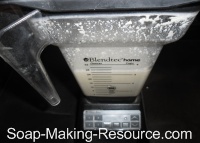
Now pour this liquid through a fine strainer or cheese cloth to filter out all the oat particles. For this step, I like to use a paint strainer bag. You can pick up one of those at your local hardware store. They are basically like cheesecloth in a bag form. Very easy to use for our application!
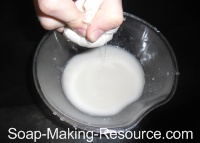
Once you have strained the oat milk, you can discard the oat particles or save them in your refrigerator for a future project or recipe.
Step 2) Next, we are going to make our lye solution for this batch. Measure out 20 ounces of your oat milk in a chemical and heat safe container. Remember that we are measuring in weight ounces, not liquid ounces here. You may have a bit left over after you measure out your needed portion, but it is better to have too much than too little!
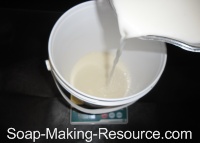
Now measure out your dry lye. For this batch, we will need 206 grams of lye. I always measure out my lye portion in grams as this smaller unit of measurement is much more accurate than measuring in ounces.
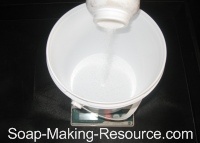
Next, pour your lye portion into the oat milk slowly and carefully. You will notice that the reaction between the two components will cause the solution to heat up and for a strong fume to be present. Be sure to create your lye solution in a well-ventilated area and away from children and pets.
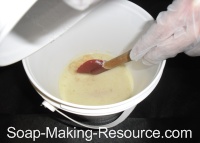
Set a candy thermometer into your lye solution and set it safely off to the side to cool. We want our lye solution to drop in temperature to somewhere below 110 degrees.
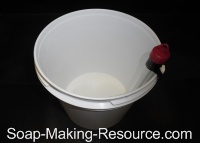
Step 3) Next, we are going to measure out our oils. In your stainless steel soap making pot, weigh out each of the oils needed for this batch as explained above in the lavender soap recipe. Measure as accurately as possible!
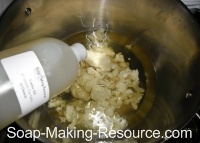
Step 4) Now that all of your soap making oils are weighed out, melt them all down to a liquid form. You can do this by placing your soap pot on your cooktop burner, but be sure to keep the burner set as low as possible so that you don't burn the oils!
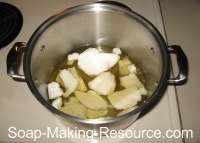
Step 5) While our oils are melting, we are going to prepare our additives needed for this lavender soap recipe.
First, let's create our colloidal oatmeal. Colloidal oatmeal is simply finely ground whole oats. You can purchase colloidal oatmeal from a health food store, or, for much less money, you can create your own at home.
Our batch calls for 4 tablespoons of colloidal oatmeal. Add a little more than 4 tablespoons of whole oats to a coffee grinder and grind them up until they turn into a very fine powder.
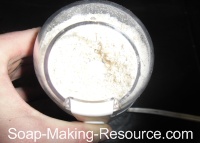
Now check to make sure that you have 4 tablespoons of the powder.
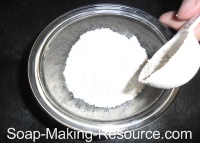
Because the colloidal oatmeal powder is more dense than the loose whole oats, if you add 4 tablespoons of whole oats to your coffee grinder, you may end up with far less of the powder by volume. So, it is always a good idea to add a little bit of extra oats to your coffee grinder to make your colloidal oatmeal. If you don't have enough powder after the first try, grind up some more whole oats until you have 4 tablespoons!
Next, weigh out the 75 grams of Soap Making Resource's lavender 40/42 essential oil into a separate container so it is ready to be added to your batch when the time is right.
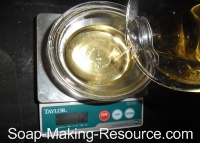
Finally, pour out a small bowl of lavender buds so that they are on hand and ready to use. The lavender buds won't be added to this lavender soap recipe batch until the very end. We will sprinkle them on top of each bar for decoration.
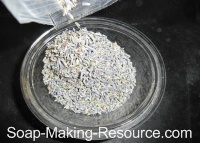
Step 6) By now, all of your oils have probably melted. Remove your soap making oils from the burner and set a thermometer into the mixture. We need to cool down the oils before using them in our batch. To do this, simply place your soap pot into a sink filled with ice water. Let the oils cool until they are 110 degrees or below. At this point, your lye solution has probably cooled down substantially, but if you need to cool it further, you can use the same method to do so.
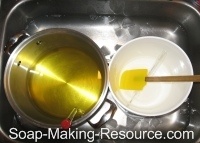
Step 7) At this point, your oat milk lye solution and oils mixture are cooled down and your additives are ready to be incorporated into your batch at a moment's notice. We are finally ready to make soap!
Carefully pour your oat milk lye solution into your soap making oils while stirring manually with your silicone spatula. Keep stirring manually until your batch is an even color and texture.
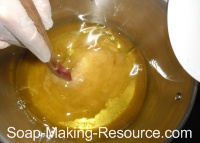
Now begin mixing with your stick blender.
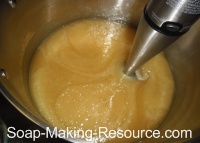
Keep mixing until you reach a thin trace. You will know that your soap has reached trace when you dribble a small amount of soap onto the rest of the batter and it lays on the surface for a brief period before sinking back into the rest of the batch.
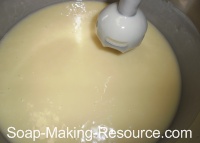
Now that your soap has reached a light trace, pour in your measured out lavender 40/42 essential oil.
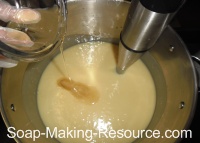
Mix your batch once again until your each an even color and texture.
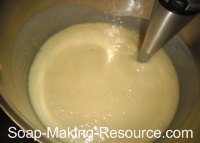
Next, pour in your colloidal oatmeal.
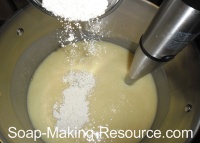
Thoroughly mix in all the colloidal oatmeal. You can do this manually or use your stick blender. Up to you!
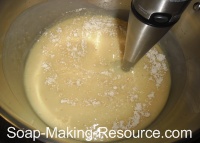
Step 8) Now that all the lavender soap recipe components are thoroughly mixed into your batch, you are ready to pour the soap into your mold.
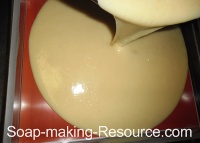
For this batch, I am using the Soap Making Resource 5 pound acrylic slab soap mold. I prefer to use a slab mold for this batch so that I can sprinkle some lavender buds onto the top of each bar. This would not be possible when using a log soap mold.
Below is a picture of me adding lavender buds to the top of my soap. This addition really adds something nice to the final product.
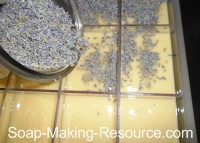
Allow your soap to set in the mold for about 24 hours or until fully solidified. Once you are able to remove the soap from the mold without damage, go ahead and do so.
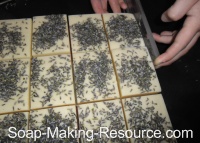
Step 9) Once each bar is removed from the mold, allow them to set on a rack to cure.
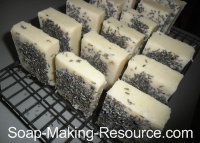
Your soap should cure for about 6-8 weeks in order to allow excess water to evaporate from each bar. This extended cure time will cause your finished product to be very hard and long lasting.
Step 10) Finally, enjoy using your all natural lavender soap!
I sincerely hope that you all enjoyed this lavender soap recipe tutorial. I think that you will love making and using this bar!
Don't forget, you can pick up the kit right here at soap-making-resource.com and complete this lavender soap recipe for yourself. You can also purchase in bulk any of the ingredients used in our demonstration.
Return from the lavender soap recipe to the soap recipes hub page.

